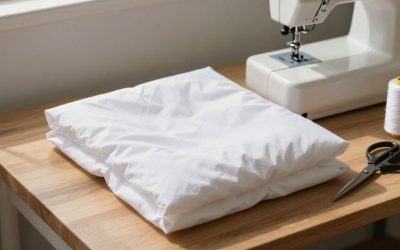When shopping for a new pillow, you might be stymied by the variety of shapes, materials, and designs in pillows available. The two most common types of pillows are microfiber pillows and memory foam pillows, and their differences should be considered before you make a purchase. In this article, we’ll compare microfiber pillows and memory foam pillows in terms of types, benefits, drawbacks, cost, durability, comfort, maintenance, and cleaning requirements. Taking all of these factors into account can help you make an informed decision and purchase the best pillow for you.
Types of Pillows
Microfiber pillows are generally made from polyester or rayon microfibers, which are tightly woven to create a durable but light material. The microfibers are usually enclosed in a quilted cover, which further increases the pillow’s durability and can give it a more decorative appeal. Some microfiber pillows are filled with down or feathers, while others are filled with polyester fibers. Memory foam pillows are made from dense visco-elastic foam, which is a type of foam that provides cushioning and support. The foam is usually covered in a removable outer layer for additional protection.
Benefits of Microfiber Pillows
The main advantage of microfiber pillows is their lightweight properties. They can be easily moved, adjusted, and fluffed up to provide maximum comfort. They are also quite affordable and come in a wide range of prices, making them a good choice for those on a tight budget. Furthermore, because of their construction material, they often provide less heat retention than other types of pillows, making them ideal for hot sleepers. Finally, microfiber pillows are typically hypoallergenic, making them ideal for those who suffer from allergies.
In addition, microfiber pillows are highly durable and can last for many years with proper care. They are also easy to clean and maintain, as they can be machine washed and dried. This makes them a great choice for those who want a pillow that is both comfortable and long-lasting.
Benefits of Memory Foam Pillows
Memory foam pillows are most well-known for their superior comfort and support features. The dense visco-elastic foam contours to the shape of your head and neck, providing custom support as you sleep. Memory foam pillows also have anti-microbial properties that inhibit the growth of dust mites, mold, and mildew. Furthermore, these pillows can help prevent neck and back pain by providing the perfect balance of cushioning and support.
In addition to the comfort and support benefits, memory foam pillows are also highly durable and long-lasting. Unlike traditional pillows, memory foam pillows will not flatten or lose their shape over time. This makes them an excellent investment for those looking for a pillow that will last for years to come.
Drawbacks of Microfiber Pillows
The biggest drawback of microfiber pillows is that they tend to flatten more quickly than other types of pillows. This means that over time the pillow may require more regular fluffing and reshaping. Additionally, since microfiber pillows are typically filled with synthetic materials, it can be difficult to properly air them out when needed.
Another potential downside of microfiber pillows is that they may not be as comfortable as other types of pillows. This is because the synthetic materials used to fill the pillow may not be as soft or supportive as natural materials. Additionally, the pillow may not be as breathable as other types of pillows, which can lead to overheating during sleep.
Drawbacks of Memory Foam Pillows
Though memory foam pillows offer superior comfort and much-needed support, they tend to be more expensive than other types of pillows. Furthermore, memory foam pillows can generate heat while you sleep due to the dense material they are constructed from. They can also trap moisture if not properly dried or aired out after use.
In addition, memory foam pillows can be difficult to clean. The dense material can make it difficult to remove stains or odors, and the pillow may need to be replaced if it becomes too soiled. Memory foam pillows also tend to be heavier than other types of pillows, making them difficult to move or adjust during the night.
Finally, memory foam pillows may not be suitable for people with allergies. The dense material can trap dust, pollen, and other allergens, which can cause irritation or discomfort. It is important to choose a pillow with a removable cover that can be washed regularly to reduce the risk of allergies.
Cost Comparison
Microfiber pillows can range greatly in price depending on the size and quality of the pillow. Generally speaking, they tend to be cheaper than memory foam pillows, with prices starting as low as $15-$25 for a single pillow. Memory foam pillows have a much wider price range, typically starting at around $50 for a single pillow.
When comparing the two types of pillows, it is important to consider the quality of the materials used. Microfiber pillows are usually made from synthetic materials, while memory foam pillows are made from a combination of synthetic and natural materials. Memory foam pillows tend to be more durable and provide better support than microfiber pillows, but they are also more expensive. Ultimately, the choice between the two types of pillows will depend on the individual’s needs and budget.
Durability Comparison
Microfiber pillows can be quite durable if taken care of properly and are machine washable. However, their ability to hold their shape may decline over time, meaning they will require regular fluffing and reshaping. Memory foam pillows tend to last much longer than microfiber pillows if properly cared for. However, they may start to degrade or flatten quicker if constantly exposed to heat or moisture.
In addition, memory foam pillows are more resistant to dust mites and allergens than microfiber pillows, making them a better choice for those with allergies. Memory foam pillows also tend to be more expensive than microfiber pillows, so it is important to consider your budget when making a decision.
Comfort Comparison
In terms of comfort, microfiber pillows tend to provide enough cushioning to keep your head comfortable while sleeping. However, they lack the firm support that some people need. Memory foam pillows offer much more support thanks to their unique contouring properties. The dense visco-elastic foam cradles your head and neck as it contours to your body shape.
Memory foam pillows are also great for people who suffer from neck and shoulder pain, as the foam helps to reduce pressure points and provide relief. Additionally, memory foam pillows are hypoallergenic and dust mite resistant, making them a great choice for people with allergies or sensitivities.
Maintenance and Cleaning Requirements
If properly cared for and regularly washed, microfiber pillows can last many years without replacement. To keep your pillow clean and in optimal shape, spot-clean any spills or stains and air regularly. For memory foam pillows, be sure to dry them off after use and allow them to air out prior to storing them in order to prevent the build-up of moisture.
It is also important to regularly rotate your pillow to ensure even wear and tear. Additionally, you should consider using a pillow protector to help keep your pillow clean and free from dust mites. Pillow protectors are also great for extending the life of your pillow and can be easily washed in the washing machine.
Final Considerations for Choosing the Right Pillow
When considering a pillow purchase, consider the differences between microfiber pillows and memory foam pillows outlined in this article. Selecting the right pillow depends on individual comfort needs and budget restrictions. Weigh the pros and cons carefully and try out different types of pillows to find the one that best suits your needs. Knowing the available options will enable you to make a more educated decision when purchasing your next pillow.
It is also important to consider the size of the pillow when making a purchase. Pillows come in a variety of sizes, from standard to king size. Make sure to measure the size of your bed and the size of the pillow you are considering to ensure a proper fit. Additionally, consider the type of pillowcase you will need to purchase to ensure the pillow fits properly.



